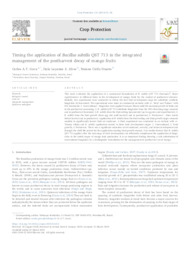Timing the application of Bacillus subtilis QST 713 in the integrated management of the postharvest decay of mango fruits.
Timing the application of Bacillus subtilis QST 713 in the integrated management of the postharvest decay of mango fruits.
Autoria: GAVA, C. A. T.; ALVES, I. L. S.; DUARTE, N. C.
Resumo: This work evaluated the application of a commercial formulation of B. subtilis QST 713 (Serenade®, Bayer AgroSciences) at different times in the development of mango fruits for the control of postharvest diseases. Initially, two experiments were conducted to define the best fruit development stage for substitute synthetic fungicides by biocontrol. The experiments were made in commercial orchards with cv. ?Kent? and ?Palmer? with five treatments: 1. Conventional ? fungicides were applied from pre-bloom until the maximal growth of fruits and in the postharvest processing; 2. B. subtilis QST 713 substitute fungicides from the 50% flowering stage onwards and in postharvest treatment; 3. B. subtilis from the fruit-setting (peanut size) up to egg size and in postharvest; 4. B. subtilis from the fruit growth (from egg size until harvest) and in postharvest; 5. Preharvest ? three weeks before harvest and in postharvest. Application of B. subtilis from the fruit setting and fruit growth stages onwards resulted in significantly lowest fruit rot incidence. A third experiment was conducted in an orchard with cv. Tommy Atkins and B. subtilis application started in three fruit development stages: 1. Conventional; 2. Fruit growth; 3. Preharvest. There was a significant reduction of rot incidence, severity, and lesion development rate through the shelf life period for the application starting fruit growth onward. Our results showed that B. subtilis QST 713 applied after the mid-stage of fruit development can efficiently complement the application of fungicides in the initial stages of mango fruit production. It is an important finding showing a safe substitution of conventional fungicides by a biofungicide formulation for the management of postharvest rot of mango.
Ano de publicação: 2019
Tipo de publicação: Artigo de periódico
Unidade: Embrapa Semiárido
Observações
1 - Por padrão são exibidas publicações dos últimos 20 anos. Para encontrar publicações mais antigas, configure o filtro ano de publicação, colocando o ano a partir do qual você deseja encontrar publicações. O filtro está na coluna da esquerda na busca acima.
2 - Para ler algumas publicações da Embrapa (apenas as que estão em formato ePub), é necessário ter, no celular ou computador, um desses softwares gratuitos. Sistemas Android: Google Play Livros; IOS: iBooks; Windows e Linux: software Calibre.
Acesse outras publicações
Acesse a Base de Dados da Pesquisa Agropecuária (BDPA) para consultar o acervo completo das bibliotecas da Embrapa.

